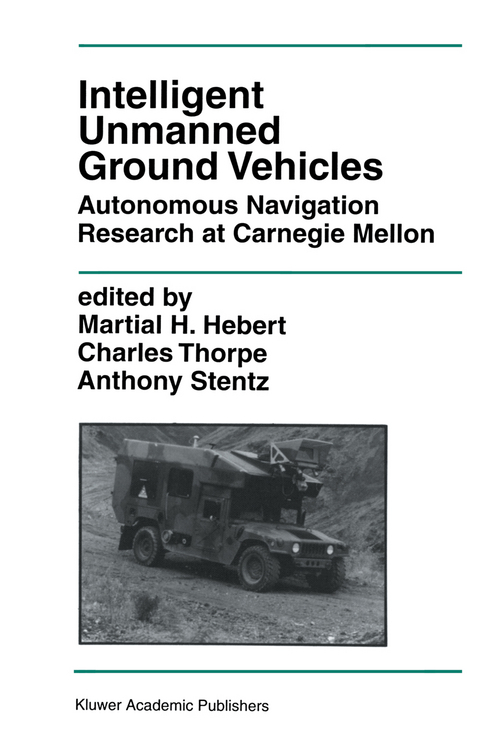
Intelligent Unmanned Ground Vehicles
Springer-Verlag New York Inc.
978-1-4613-7904-1 (ISBN)
Intelligent Unmanned Ground Vehicles shows the progress that was achieved during this program, from brittle specially-built robots operating under highly constrained conditions, to groups of modified commercial vehicles operating in tough environments. One measure of progress is how much of this technology is being used in other applications. For example, much of the work in road-following, architectures and obstacle detection has been the basis for the Automated Highway Systems (AHS) prototypes currently under development. AHS will lead to commercial prototypes within a few years. The cross-country technology is also being used in the development of planetary rovers with a projected launch date within a few years. The architectural tools built under this program have been used in numerous applications, from an automated harvester to an autonomous excavator.
The results reported in this work provide tools for further research development leading to practical, reliable and economical mobile robots.
1 Introduction.- 1.1 Overview.- 1.2 The HMMWV Testbed.- 1.3 Key Software Components.- 1.4 Integrated Systems.- 1.5 Acknowledgments.- 2 A Behavior-based Architecture for Mobile Navigation.- 2.1 Introduction.- 2.2 The Distributed Architecture for Mobile Navigation.- 2.3 Command Arbitration.- 2.4 Behaviors.- 2.5 Evolutionary Development and Integration.- 2.6 Extensions.- 2.7 Conclusion.- 3 SAUSAGES: Between Planning and Action.- 3.1 Introduction.- 3.2 The road to SAUSAGES.- 3.3 Description of SAUSAGES.- 3.4 Implementation of SAUSAGES.- 3.5 SAUSAGES and Annotated Maps.- 3.6 SAUSAGES and planners.- 3.7 Conclusions.- 4 Neural Network Vision for Robot Driving.- 4.1 Introduction.- 4.2 Network Architecture.- 4.3 Network Training.- 4.4 Performance Improvement Using Transformations.- 4.5 Results and Comparison.- 4.6 Discussion.- 5 Vision-Based Neural Network Road and Intersection.- 5.1 Introduction.- 5.2 The virtual camera.- 5.3 Detection philosophy.- 5.4 Other systems.- 5.5 Experimental results.- 5.6 Conclusions and future work.- 6 SMARTY: Point-Based Range Processing for Autonomous Driving.- 6.1 Introduction.- 6.2 Range Date Acquisition.- 6.3 Updating Cell State.- 6.4 Local Map and Arc Generation.- 6.5 Maintaining Transformations and Scrolling.- 6.6 Performance.- 7 RANGER: Feedforward Control Approach to Autonomous Navigation.- 7.1 Introduction.- 7.2 Differences from Previous Systems.- 7.3 Analytical Basis of the Concept.- 7.4 Hierarchical Planning and Arbitration.- 7.5 Path Tracking.- 7.6 Adaptive Regard.- 7.7 Real Time Latency Modelling.- 7.8 Feedforward Simulation.- 7.9 Tactical Planning.- 7.10 Speed Planning.- 7.11 High Speed Autonomy as an Optimal Control Problem.- 8 Sensor Fusion For Autonomous Navigation Using Neural Networks.- 8.1 Introduction.- 8.2 The Task at Hand.- 8.3 Network Architecture.- 8.4 Experiments and Results.- 8.5 Conclusion.- 9 Sonar-Based Outdoor Vehicle Navigation.- 9.1 Introduction.- 9.2 Hardware Configuration.- 9.3 Local Grid Map.- 9.4 Obstacle Avoidance.- 9.5 Object Tracking.- 9.6 Parallel Parking.- 9.7 Results and Conclusions.- 10 STRIPE: Low-Bandwidth and High-Latency Teleoperation.- 10.1 Introduction.- 10.2 Other Low-Bandwith High-Delay Systems.- 10.3 STRIPE Implementation Details.- 10.4 Investigating the Interface.- 10.5 Conclusion.- 11 Optimal and Efficient Path Planning for Partially Known Environments.- 11.1 Introduction.- 11.2 The D* Algorithm.- 11.3 Soundness, Optimality, and Completeness.- 11.4 Experimental Results.- 11.5 Conclusions.- 12 Dynamic Mission Planning for Multiple Mobile Robots.- 12.1 Introduction.- 12.2 Problem Statement.- 12.3 Technical Approach.- 12.4 Prototype System.- 12.5 Results.- 12.6 Conclusion and Future Work.- 13 Integrating Position Estimation and Perception for Navigation.- 13.1 Introduction.- 13.2 Position Measurement and Error Modeling.- 13.3 Annotated Maps.- 13.4 Filtered Position Updates.- 13.5 Experiments and Results.- 13.6 Conclusion.- 14 An Integrated System for Autonomous Off-Road Navigation.- 14.1 Introduction.- 14.2 System Overview.- 14.3 Autonomous Navigation: An Experiment.- 14.4 Perception.- 14.5 Local Map Management.- 14.6 Path Planning.- 14.7 Combining Obstacle Detection and Goal Seeking: An Example.- 14.8 System Performance and Future Work.- 15 A Navigation System for Goal Acquisition in Unknown Environments.- 15.1 Introduction.- 15.2 The Navigation System.- 15.3 Experimental Results.- 15.4 Conclusion.
| Erscheint lt. Verlag | 12.10.2012 |
|---|---|
| Reihe/Serie | The Springer International Series in Engineering and Computer Science ; 388 |
| Zusatzinfo | 309 p. |
| Verlagsort | New York, NY |
| Sprache | englisch |
| Maße | 155 x 235 mm |
| Themenwelt | Sachbuch/Ratgeber ► Natur / Technik ► Garten |
| Informatik ► Theorie / Studium ► Künstliche Intelligenz / Robotik | |
| Technik ► Maschinenbau | |
| ISBN-10 | 1-4613-7904-0 / 1461379040 |
| ISBN-13 | 978-1-4613-7904-1 / 9781461379041 |
| Zustand | Neuware |
| Haben Sie eine Frage zum Produkt? |
aus dem Bereich


